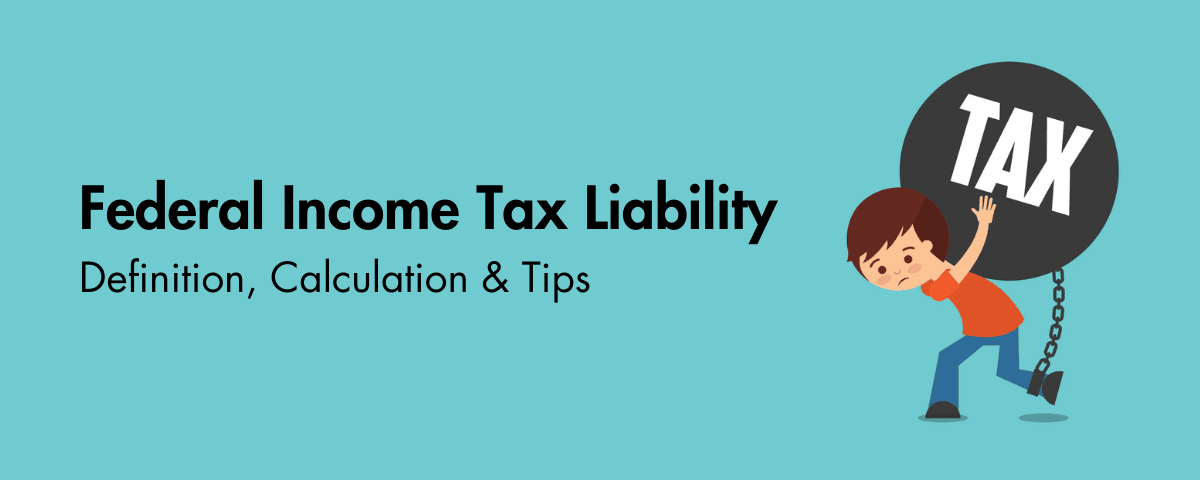That is what you want too, clarity you can trust. In this guide, I will show you how your federal income tax liability is built step by step, where you can legally shrink it, and what to check before you file so you avoid penalties and cash flow surprises. All figures are current for the 2025 tax year, the return you typically file by April 15, 2026.
Quick note for firms: if your team is underwater during peak season, you can still give clients this level of clarity. Accountably’s white‑label back office teams follow U.S. compliance standards, IRS rules, and GAAP, and they slide into your workflows so you keep quality high while you scale advisory time. Use us only where it actually helps. No fluff.
Table of Contents
- Key Takeaways
- What “Federal Income Tax Liability” Really Means
- How Federal Income Tax Is Determined, The Five-Step Flow
- Calculating Your Taxable Income
- Using Tax Brackets To Compute Your Tax
- Capital Gains And Qualified Dividends
- Withholding, Estimated Payments, And Refunds
- Strategies To Reduce Your 2025 Tax Liability
- Worked Example, 2025 Married Filing Jointly
- FAQs
- Final Checklist For This Filing Season
Key Takeaways
- Your federal income tax liability is the total tax after you apply deductions, compute tax using the brackets, then subtract credits, and finally net out withholding and estimated payments.
- For 2025, the standard deduction is 15,000 single or MFS, 30,000 MFJ or qualifying surviving spouse, and 22,500 head of household. Additional amounts for age 65 or blindness are 2,000 if single or HOH and 1,600 per qualifying person if married.
- Ordinary income is taxed with progressive brackets from 10% up to 37%, with 2025 thresholds indexed for inflation.
- Long‑term capital gains and qualified dividends generally use 0%, 15%, or 20% rates, with updated 2025 income thresholds. High earners may also owe the 3.8% NIIT. (bipartisanpolicy.org)
- To avoid underpayment penalties, most people must prepay at least 90% of current‑year tax or 100% of prior‑year tax, 110% if last year’s AGI was over 150,000. (irs.gov)
- An extension gives you more time to file, not more time to pay. Paying late can trigger interest and penalties.
Tax liability is not your top bracket. It is the net result of income, deductions, credits, and payments.
What “Federal Income Tax Liability” Really Means
Your federal income tax liability is the total federal income tax you legally owe for the year after you:
- total your income,
- reduce it with adjustments to get AGI,
- subtract the standard deduction or itemized deductions to get taxable income,
- compute tax using the progressive brackets, and
- subtract credits.
Only then do you compare that number to what you already paid through paycheck withholding and estimated payments to see if you still owe or you get a refund.
Why this matters to you
- It changes how you make decisions in real time. When you know which dollars are taxed at which rate, you can time income, deductions, and asset sales with intent.
- It keeps cash flow steady. Dialing in withholding or estimates helps you avoid an April surprise.
- It helps you explain taxes to a client, a partner, or your future self in five minutes without a spreadsheet.
A quick word for firms
If you lead a CPA firm or EA practice, tax liability is where clients feel your value. If workload spikes, bring in help only where it improves the client experience. Accountably can supply trained offshore staff that work inside your SOPs, so your name stays front and center and your review time drops. Keep reading for the full walkthrough, then decide if extra hands would let you spend more time on high‑value planning, not just form prep.
How Federal Income Tax Is Determined, The Five-Step Flow
At a high level, the process is linear. You can even print this and check boxes as you go.
| Step | What You Do | Why It Matters |
| 1 | Add up all taxable income | Sets your starting point for AGI |
| 2 | Subtract adjustments to income to get AGI | Lowers the base for many thresholds |
| 3 | Subtract the standard deduction or itemized deductions | Produces taxable income |
| 4 | Apply the brackets to ordinary income, then apply special rates to long‑term gains and qualified dividends | Calculates your gross tax |
| 5 | Subtract credits, then compare to withholding and estimates | Shows your refund or balance due |
Calculating Your Taxable Income
You start with total income, then work down.
Step 1 – Total your income sources
Include wages and tips, self‑employment income, taxable interest and non‑qualified dividends, qualified dividends, capital gains, taxable retirement distributions, rental income, unemployment, and other taxable items. Exclude nontaxable items like most gifts and life insurance proceeds. Retirement plan contributions made pre‑tax and employer‑paid health insurance typically reduce taxable pay at the source.
Step 2 – Adjusted Gross Income, AGI
From total income, subtract above‑the‑line adjustments such as deductible HSA contributions, deductible traditional IRA contributions if eligible, and the deductible half of self‑employment tax. Your AGI affects many phase‑outs and credit thresholds, so it is a key number.
Step 3 – Standard deduction vs itemizing
For 2025, the standard deduction is:
- Single or Married Filing Separately, 15,000
- Married Filing Jointly or Qualifying Surviving Spouse, 30,000
- Head of Household, 22,500. (taxfoundation.org)
If you are 65 or older or blind, add the extra amount on top of the standard deduction, 2,000 if you are single or HOH and 1,600 per qualifying person if you are married. These amounts are separate from any new policy chatter you may see on social media. Always use the IRS inflation‑adjusted numbers that apply to the year you are filing. (taxnotes.com)
Itemize only if your total itemized deductions exceed your standard deduction. Typical itemized deductions include mortgage interest on qualified loans, charitable gifts, allowable medical expenses above 7.5% of AGI, and state and local taxes up to the federal SALT cap.
Quick gut check, most filers take the standard deduction. Homeowners with sizable mortgage interest, large charitable giving, or high medical costs may benefit from itemizing.
Step 4 – Taxable income
Taxable income equals AGI minus your standard deduction or itemized deductions. This number drives your bracket placement and the rate applied to any long‑term capital gains and qualified dividends.
Using Tax Brackets To Compute Your Tax
The U.S. uses progressive rates, so you tax each slice of your taxable income at its own rate. For 2025, the rates are the same, 10%, 12%, 22%, 24%, 32%, 35%, and 37%, but the dollar thresholds moved up with inflation. The top rate of 37% starts at taxable income above 626,350 for single filers and 751,600 for married filing jointly. (content.govdelivery.com)
Two definitions you will use all year:
- Your marginal rate is the rate on your next dollar of taxable income.
- Your effective rate is total tax divided by taxable income. It is almost always lower than your marginal rate because the lower slices are taxed at lower rates.
A simple mechanical example
Imagine 175,000 of taxable income as a married couple filing jointly in 2025. You will fill the lower brackets first at their lower rates, then only the top slice lands in the 24% bracket. That is why the overall effective rate is lower than 24%. If you prefer, use the IRS tax tables or a reputable calculator, but make sure the tool is updated for 2025 thresholds.
Capital Gains And Qualified Dividends
Long‑term capital gains and qualified dividends get preferential rates. For 2025, most filers will fall into the 0%, 15%, or 20% long‑term capital gains brackets, based on taxable income. Thresholds increased again, for example the 15% rate for married filing jointly runs from 96,701 up to 600,050, and the 20% rate begins above that amount. Short‑term gains are taxed at ordinary rates. (bipartisanpolicy.org)
Here is a quick view of 2025 long‑term capital gains thresholds:
| Filing status | 0% rate up to | 15% rate | 20% rate starts |
| Single | 48,350 | 48,351 to 533,400 | 533,401+ |
| Head of Household | 64,750 | 64,751 to 566,700 | 566,701+ |
| Married Filing Jointly | 96,700 | 96,701 to 600,050 | 600,051+ |
| (bipartisanpolicy.org) |
High‑income investors may also owe the 3.8% Net Investment Income Tax, NIIT, which applies when modified AGI exceeds 200,000 for single or head of household and 250,000 for MFJ. These NIIT thresholds are not indexed for inflation.
Practical planning moves for gains
- Hold for the long term when it aligns with your investment plan so gains can qualify for the preferential rate.
- Pair gains with losses. Realized capital losses offset gains dollar for dollar, then up to 3,000 of ordinary income. Excess losses carry forward.
- Watch how realizing a large gain can push other dollars into a higher bracket or reduce credits.
- If you are near the 0% long‑term bracket, model a small harvest of gains to reset basis at little or no federal tax cost.
If you are a firm owner helping investors, standardize a year‑end capital gains checklist for your staff. If you need help turning that into a repeatable workflow, this is one of those spots where Accountably’s white‑label teams can build and run the checklist inside your practice, then your seniors review and sign off.
Withholding, Estimated Payments, And Refunds
Taxes are paid throughout the year. You pay through wage withholding and, when needed, quarterly estimated payments. At filing time, you reconcile what you owe with what you already paid.
- Use the IRS Tax Withholding Estimator and file a fresh Form W‑4 if your refund or balance due is routinely large.
- If you have non‑wage income, make quarterly estimates with Form 1040‑ES.
Safe harbor rule of thumb, to avoid an underpayment penalty for 2025 most people must pay in the smaller of 90% of current‑year tax or 100% of their 2024 tax. If your 2024 AGI was more than 150,000, use 110% of your 2024 tax. (irs.gov)
An extension gives you more time to file, not more time to pay. If you need more time to file your 2025 return, request an extension by the April deadline. Interest and penalties can apply if you pay after that date. (irs.gov)
Put it on your calendar now, file the extension if you need it, and send a payment with it if you expect to owe.
Strategies To Reduce Your 2025 Tax Liability
These are practical moves that matter, with current limits.
- Max out pre‑tax workplace retirement plans. The 2025 elective deferral limit for 401(k), 403(b), most 457 plans, and the federal TSP is 23,500. Age 50+ catch‑up is 7,500, and there is a special higher catch‑up of 11,250 for ages 60 through 63.
- Use your IRA if eligible. The 2025 IRA contribution limit is 7,000, with a 1,000 catch‑up if you are 50 or older. Deductibility or Roth eligibility depends on income and coverage by a workplace plan.
- Fund your HSA if you have an HSA‑qualified high‑deductible health plan. For 2025, the HSA limit is 4,300 self‑only and 8,550 family, with a 1,000 catch‑up at age 55+. HSAs offer triple tax benefits, contributions reduce taxable income, growth is tax‑deferred, and qualified withdrawals are tax‑free. (grantthornton.com)
- Harvest losses in taxable accounts when markets give you the chance, and mind the wash‑sale rule. Coordinate with your advisor so you do not accidentally block a deduction.
- Choose the standard deduction unless itemizing saves you more. For itemizers, track mortgage interest, charitable giving receipts, medical expenses above 7.5% of AGI, and SALT up to the federal cap. For seniors or those who are blind, remember the additional standard deduction amounts. (taxnotes.com)
- Mind timing. Bunch deductible medical or charitable expenses into one year to clear floors or make itemizing pay off. Defer income if it keeps you in a lower bracket or preserves credits.
For firm leaders
If your preparers are spending evenings wrestling with 1040‑ES projections or HSA reconciling, that is a sign to free senior time. Accountably’s trained staff can build standardized workpapers, tie out contribution limits to IRS sources, and push clean files to your reviewers, all inside your software stack. You keep quality control and client relationships while expanding capacity.
Worked Example, 2025 Married Filing Jointly
Let’s make it tangible. Assume a couple has 210,000 of gross income in 2025, consisting of wages, some interest, and 10,000 of long‑term gains.
- Adjustments. None for simplicity, so AGI is 210,000.
- Deduction. They take the standard deduction of 30,000 for MFJ, so taxable income is 180,000. (taxfoundation.org)
- Compute tax. Ordinary income is 170,000 after separating the 10,000 of long‑term gains. Apply the progressive brackets to the ordinary slice, then compute the long‑term capital gains tax using the 2025 thresholds for MFJ. The gains likely fall in the 15% long‑term bracket for this income level.
- Credits. Subtract any credits they qualify for.
- Payments. Compare the final tax to total withholding and estimates. If they prepaid enough, they get a refund. If not, they owe a balance and should adjust withholding or estimates for next year to avoid penalties. Safe harbor math applies.
FAQs
How do I know if I will have no federal income tax liability?
You will have no liability if your computed tax is zero after deductions and credits. A common scenario is taxable income reduced to zero by the standard deduction or credits that fully offset the tax. Use the IRS estimator or run a draft return with 2025 numbers to confirm.
What does “no federal income tax liability” actually mean?
It means your tax for the year is zero after the bracket calculation and credits. You could still owe other taxes, for example self‑employment tax, and you might still want withholding to cover state taxes.
What income is exempt from federal income tax liability?
Examples include gifts, most life insurance proceeds, and qualified municipal bond interest. Always confirm the rules for your situation and keep documentation. When in doubt, check the instructions for Form 1040 and related IRS publications or ask a professional.
How do withholding and estimated payments affect my tax bill?
They do not change your liability, they prepay it. At filing, you net your total tax against what you already paid. If you did not pay enough during the year, you can owe a penalty unless you met a safe harbor. (irs.gov)
I filed an extension. Do I still have to pay by April?
Yes. An extension gives you more time to file your paperwork, not more time to pay. If you expect to owe, send a payment by the April deadline to curb penalties and interest. (irs.gov)
Final Checklist For This Filing Season
- Confirm your filing status and use the correct 2025 standard deduction. (taxfoundation.org)
- Separate ordinary income from long‑term gains and qualified dividends. Apply the right brackets for each.
- Review credits you actually qualify for.
- Reconcile withholding and estimated payments. Meet the safe harbor to avoid penalties.
- If you need more time to file, request an extension, then pay what you expect to owe by the April deadline.








